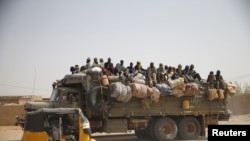New data by the International Organization for Migration show a significant increase in the number of migrants journeying across the Sahara desert from West Africa to Algeria and Libya and then onwards to Europe.
The report finds more than 60,000 migrants have transited through the Agadez region of Niger between February and April. It says close to two-thirds were recorded leaving Niger for North Africa, while the rest was composed of migrants returning to Niger and entering the country.
The largest number of migrants surveyed come from Nigeria and Niger. Other nationalities include Senegalese, Gambians, Malians and Cameroonians.
IOM spokesman Joel Millman says the upsurge in the number of migrants crossing the Sahara is largely due to the cheap prices smugglers are charging to get them to the transit towns of Arlit and Seguedine in Niger.
“The average cost of migration is anywhere between U.S. $85 and U.S. $345. So, that should give you an indication," said Millman. "If you can cross the Sahara and get to Agadez for as little as $85, this would explain why the traffic has been so robust for this last year.”
While it may be cheap to cross the desert, Millman tells VOA this is not a trip that should be lightly undertaken. He says the journey is dangerous and many people reportedly do not survive.
He says thousands reportedly have died over the past decade, but he adds IOM does not have any comprehensive data to back this up. He says most of the information received comes anecdotally from the migrants.
“When we talk to migrants, many, many, many of them have witnessed the death while crossing the Sahara ," said Millman. "They talk about dehydration. They talk about vehicle accidents and, occasionally, we even get guerrilla video, you can call it. Things that people shoot on their cell phones…Sometimes quite dramatic of desiccated bodies and people crying over corpses, which we are told are common occurrences in the Sahara.”
While the migratory flow from Africa is increasing, so is that of migrants returning to Africa. IOM reports more than 16,000 headed back to Niger between February and April. All migrants returning from Libya stated war and insecurity as their reasons for leaving that country.








